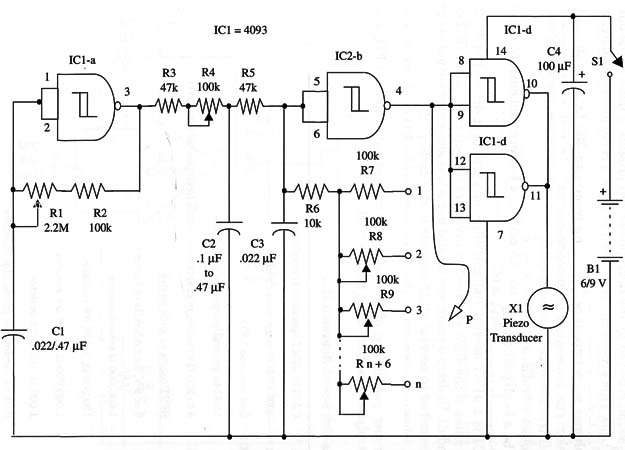As in Project ART129E, the notes are produced by touching the probe on the keyboard. The transducer is a piezoelectric unit, but if you want higher audio levels, you can use a transistorized output stage driving a loudspeaker. Other projects in this book show how to make the necessary modifications.
The electronic organ is powered from four AA cells or a battery, and current drain is very low, ranging from 0.5 mA When the tone is off to 5 mA When the tone is on.
A schematic diagram of the Electronic Organ With Vibrato is shown in Fig. 1.

The keyboard is made as described in Project ART129E. C1 and C2 can be altered to change the vibrato effect. If you want more than seven notes to be produced by the organ, use 470 k ohm or 1 M ohm units.
X1 Piezoelectric transducer, Radio Shack 27 3-07 3 or equivalent
S1 SPST toggle or slide switch
B1 6 or 9 V, four AA cells or battery
P Probe (see text)
R1 2,200,000 ohm potentiometer or trimmer potentiometer
R2 100,000 ohm, 1/4 W, 5% resistor
R3 47,000 ohm, 1/4 W, 5% resistor
R4 100,000 ohm potentiometer or trimmer potentiometer
R5 47,000 ohm, 1/4 W, 5% resistor
R6 10,000 ohm, 1/4 W, 5% resistor
R7 to Rn+6 Trimmer potentiometers, 100,000 ohm
C1 0.22 µF or 0.47 µF ceramic or metal íilm capacitor
C2 0.1 to 0.47 µF ceramic or metal film capacitor
C3 0.022 µF ceramic or metal film capacitor
C4 100 µF, 16 WVDC electrolytic capacitor



